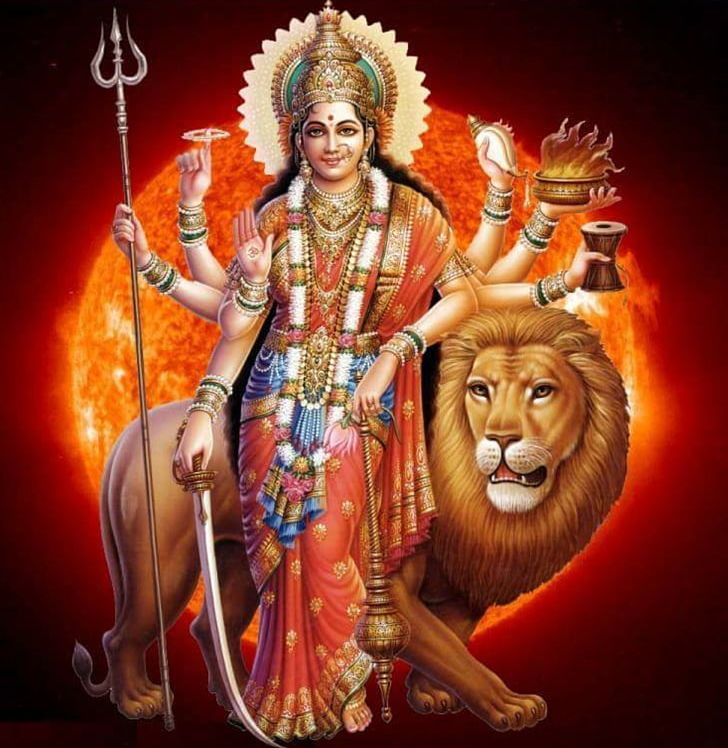Veda Purusha Saptaha Jnana Yajna at Prasanthi Nilayam,
Dasara Celebrations Program Schedule, 2019 - Click
Navaratri
Navaratri (Sanskrit: नवरात्रि, literally "nine nights"), also spelled Navratri or Navarathri, is a nine nights (and ten days) festival, during which Shakti-Devi Maa Durga and her nine Avatars are celebrated and praised for winning the battle of Good over Evil and restoring Dharma in Humanity.
During Navarathri celebrations the Durga Puja festival is dedicated to the divine feminine Devi Maa Durga where Her worshiped idol is emerged into the water while the evil idol is totally burnt in fire and ceremonious fire-crackers.
Abundance in good harvest and peace is also celebrated.
These nine days are solely dedicated to Devi Maa Durga and her nine Avatars Maa Shailaputri, Maa Brahmcharini, Maa Chandraghanta, Maa Kushmanda, Maa Skandmata, Maa Katyayani, Maa Kalratri, Maa Mahagauri, Maa Siddhidatri. Each day is associated to an incarnation of the Mata Rani.

"...the common theme is the battle and victory of Good over Evil based on a regionally famous epic or legend such as the Ramayana or the Devi Mahatmya..."
"...a storied battle between good and evil, where the Devi manifesting as goddess Durga leads the forces of good against the demon Mahishasura—the goddess is very angry and ruthless, and the forces of good win..."
"The Devi Mahatmya or Devi Mahatmyam (Sanskrit: devīmāhātmyam, देवीमाहात्म्यम्), or "Glory of the Goddess") is a Hindu religious text describing the Goddess as the supreme power and creator of the universe.[1][2]"
It is part of the Markandeya Purana, and estimated to have been composed in Sanskrit between 400-600 CE.[3][4][5]
Devi Mahatmyam is also known as the Durgā Saptashatī (दुर्गासप्तशती) or Caṇḍī Pāṭha (चण्डीपाठः).[6] The text contains 700 verses arranged into 13 chapters.[7][6] Along with Devi-Bhagavata Purana and Shakta Upanishads such as the Devi Upanishad, it is one of the most important texts of Shaktism (goddess) tradition within Hinduism.[8]
The Devi Mahatmyam describes a storied battle between good and evil, where the Devi manifesting as goddess Durga leads the forces of good against the demon Mahishasura—the goddess is very angry and ruthless, and the forces of good win.[9][10][11] In peaceful prosperous times, states the text, the Devi manifests as Lakshmi, empowering wealth creation and happiness.[12] The verses of this story also outline a philosophical foundation wherein the ultimate reality (Brahman in Hinduism) is female.[13][14][15] The text is one of the earliest extant complete manuscripts from the Hindu traditions which describes reverence and worship of the feminine aspect of God.[5] The Devi Mahatmya is often ranked in some Hindu traditions to be as important as the Bhagavad Gita.[16]
The Devi Mahatmya has been particularly popular in eastern states of India, such as West Bengal, Bihar, Odisha, Assam, Goa[17] as well as Nepal.[18] It is recited during Navratri celebrations, the Durga Puja festival,[19][20] and in Durga temples across India.[19][21]
Shiva Parvati Kali Durga Puja PNG

Navratri


Maa Durga Navratri Kalash
Navratri celebrated in the autumn every year. It is observed for different reasons and celebrated differently in various parts of the Indian subcontinent. Theoretically, there are four seasonal Navratri. However, in practice, it is the post-monsoon autumn festival called Sharada Navratri that is the most observed in the honor of the divine feminine Devi Maa Durga. The festival is celebrated in the bright half of the Hindu calendar month Ashvin, which typically falls in the Gregorian months of September and October.
In the eastern and northeastern states of India, the Durga Puja is synonymous with Navratri, wherein goddess Durga battles and emerges victorious over the buffalo demon to help restore Dharma. In the northern and western states, the festival is synonymous with "Rama Lila" and Dussehra that celebrates the battle and victory of Bhagwan Rama over the demon king Ravana. In southern states, the victory of different goddesses, of Bhagwan Rama or Devi Maa Saraswati is celebrated.

Durga Puja Celebration
In all cases, the common theme is the battle and victory of Good over Evil based on a regionally famous epic or legend such as the Ramayana or the Devi Mahatmya.
Celebrations include stage decorations, recital of the legend, enacting of the story, and chanting of the scriptures of Hinduism. The nine days are also a major crop season cultural event, such as competitive design and staging of pandals, a family visit to these pandals and the public celebration of classical and folk dances of Hindu culture. On the final day, called the Vijayadashami or Dussehra, the statues are either immersed in a water body such as river and ocean, or alternatively the statue symbolizing the evil is burnt with fireworks marking evil's destruction. The festival also starts the preparation for one of the most important and widely celebrated holidays, Diwali, the festival of lights, which is celebrated twenty days after the Vijayadashami or Dussehra.
: Devi Maa Durga, Devi Maa Saraswati, Bhagwan Rama











